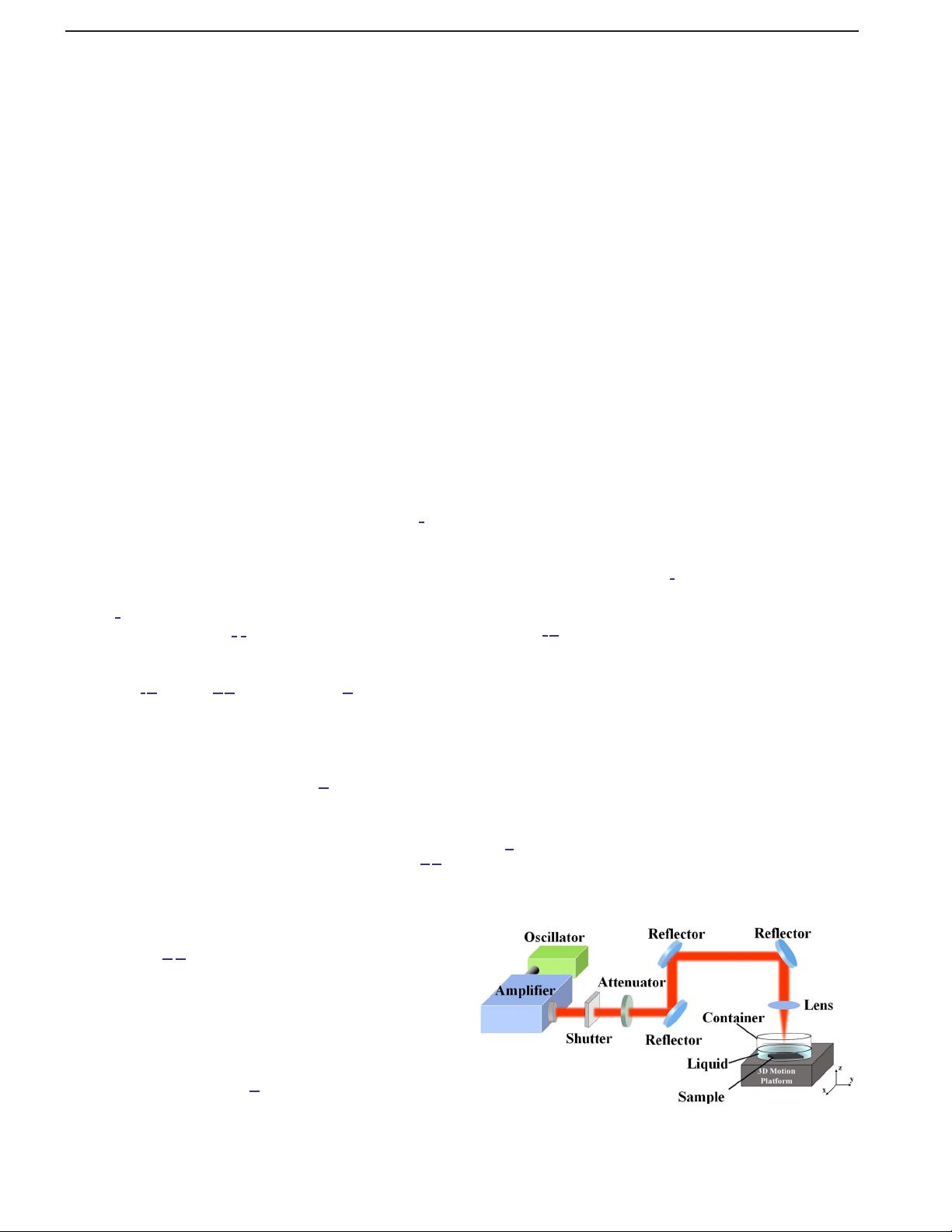
Experimental research of laser-induced periodic surface
structures in a typical liquid by a femtosecond laser
Youwang Hu (胡友旺), Haoming Yue (岳浩铭), Ji’an Duan (段吉安), Cong Wang (王 聪),
Jianying Zhou (周剑英), Yunpeng Lu (鲁云鹏), Kai Yin (银 恺), Xinran Dong (董欣然),
Wenyi Su (苏文毅), and Xiaoyan Sun (孙小燕)*
State Key Laboratory of High Performance and Complex Manufacturing, College of Mechanical and Electrical
Engineering, Central South University, Changsha 410083, China
*Corresponding author: sunxy@csu.edu.cn.
Received August 25, 2016; accepted December 15, 2016; posted online January 12, 2017
A constant elastic alloy is a widely used material with a high elastic modulus and an excellent wave velocity
consistency. Different morphologies on the constant elastic alloy surface are observed through femtosecond laser
irradiation. When the laser average fluence is set to 0.58 J∕cm
2
and 200 laser pulses, with the increasing depth of
distilled water, the period of the laser-induced periodic surface structures (LIPSS) becomes shorter accordingly.
The higher the ethanol concentration is, the more spot-shaped structures will be formed among the surface struc-
tures when the depth of the coverage of ethanol is 2 mm. The period of the LIPSS reaches its maximum when the
concentration of ethanol is 80%.
OCIS codes: 320.2250, 220.4241, 100.0118.
doi: 10.3788/COL201715.021404.
Laser-induced periodic surface structures (LIPSS) are
formed when a femtosecond laser radiates materials
[1]
.It
is generally accepted that these LIPSS are generated by
interaction of the incident laser beam with the surface
electromagnetic wave (SEW). They are usually generated
on surfaces by the excitation of surface plasmon polaritons
(SPPs)
[2]
. The growth of LIPSS remains a point of discus-
sion of many researchers
[2–8]
. Various research reported in
the literature are using ultra-short pulse lasers to generate
periodic structures on a variety of materials such as semi-
conductors
[9,10]
, metals
[11,12]
, and dielectrics
[13]
. The process-
ing parameters of a femtosecond laser include wavelength,
number of pulses, fluences, pulse duration, incident angles,
and polarization. The effects of these para meters have
been investigated on the spatial wavelength and depth
of periodic surface structure of LIPSS
[14]
. Most of the pre-
vious studies on the LIPSS focus on those structures gen-
erated with the assistance of gaseous conditions. In recent
years, some researchers have been studying LIPSS that
are generated with the assistance of various liquids
[15,16]
.
Interactions between the laser and the material in the
liquid are considerably complicated, involving a highly
confined plasma pressure, efficient cooling, enhanced
chemical reactivity, and the generation of elevated tem-
peratures, etc.
[17–19]
. Compared with LIPSS formed in gas-
eous environments, LIPSS fabricated in liquid conditions
is more significant as it has an important application such
as controlling generations of nanostruc ture and synthesis
of nanoparticles.
According to previous research, the spatial wavelength
of LIPSS in an atmospheric environment is generally
longer than that in a liquid
[14]
. Different parameters, such
as pulse width, wave length, fluence, numbers of pulses,
the kind and depth of the liquids, the surfactant, and
the nature of the target material have a great influence
on liquid assisted laser ablation. These parameters can
be taken as controlling during the processes of melting,
evaporation, plasma generation, and generate nanostruc-
tures on the ablated surface
[3]
. However, few researchers
have paid attention to the effect of different depths of
distilled water and different concentrations of ethanol
on LIPSS
[3,14]
.
In this study, a constant elastic alloy was used to study
the effect of the different femtosecond laser average fluen-
ces on the periodic surface structure. Experimental results
show how the depths of distilled water, the laser average
fluence, and the concentration of ethanol influence the
periodical surface structures. It can provide some ways
on how to employ better femtosecond laser parameters
and an ablation medium to control the periodical surface
structures.
The schematic of the experimental setup is shown in
Fig.
1. A Ti:sapphire solid femtosecond laser from Spectra
Physics Company is employed in these experiments. The
maximum single pulse energy of the laser output by the
Fig. 1. Schematic diagram of the experimental setup.
COL 15(2), 021404(2017) CHINESE OPTICS LETTERS February 10, 2017
1671-7694/2017/021404(5) 021404-1 © 2017 Chinese Optics Letters





































